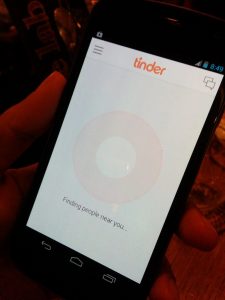
Tinder launched in 2012 with start-up incubator Hatch Labs, as a joint venture between IAC (InterActiveCorp) and Xtreme Labs. Originally called Matchbox, the app’s release date was delayed by the Apple Store’s approval process, however, reached the market by August 2012.
The platform’s primary field of operation is online dating. The app allows users to anonymously swipe to like or dislike others user’s posted profiles. Each user’s profile consists of a collection or singular photo, a short biography and a list of their personal interests. In order for two users to be able to contact one-another, they must both have ‘swiped right’ on each other’s profiles to match (Fowler, Booth, 2020). After matching, the app’s private chat feature becomes open to both users.
This chat feature is where Tinder applies its obligatory form of platform moderation and regulation. As Gillespie recognises, a platform without governance is not possible, more so, it is essential when the app is reliant on user-generated content. Tinder acts in accordance with this concept by not permitting users to send photos or videos through the chat space and their recent introduction of a user’s ability to report another user. When considering the nature of the platform, particularly how susceptible actors of the platform would be to exposure of explicit or inappropriate content, this reduces and arguably eliminates the potential of content deemed inappropriate to be shared through their platform. Tinder’s regulators have strategically eradicated the possibility of Tinder being held liable for the sharing and distribution of uncensored, graphic content upon their own platform by prohibiting private photo and video distribution.

Additionally, in the initial composition stage of a user’s profile, Tinder’s community guidelines state users must upload “No nudity. No sexually explicit content, and don’t chronicle all of your sexual desires in your bio. Keep it clean” (Tinder 2021). The platform threatens that any non-compliance with their outlined community guidelines may lead to the termination of a user’s account. The app also encourages the user-generated regulation method of self – reporting. This is another strategic tactic from the platform’s regulators in reaching and eradicating as much inappropriate behaviour as possible. The community guidelines act as a safety net for the platform’s liability in the potential circumstance of a dangerous or inappropriate exchange between users. Tinder can point to the guidelines in their defence if accused of failing to establish a safe and inclusive environment for all individuals. By allowing users to deem other user’s as non-compliant to their guidelines, Tinder’s platform regulators can manage the app extensively, since “the velocity at which users publish content means that it is impossible for platforms to pre-moderate or review it all in advance” (Flew, Martin, Suzor, 2019). This user-generated form of regulation not only empowers each user but acts as a significant benefit to the regulators attempting to pinpoint and terminate non-compliant users. As a multisided market, “governance practices, manage the many and varied conflicts likely to arise” when considering the interests of both Tinder’s users, advertisers and regulators (Lecture week 7).
Through an accumulation of factors, such as the gap in the market, the increasing reliance of digital communication, the company’s integrated marketing efforts and the sufficient level of regulation, Tinder has experienced considerable success. This prosperity can be confirmed when noting that within 12 months of launching, it was one of the top 25 social networking apps online. Within its second year, the app was registering around one billion ‘swipes’ per day and in 2019, Tinder became the highest grossing non-gaming app, overtaking Netflix with 6 million paying subscribers (Iqbal, 2021).

Additionally, the Covid-19 pandemic has only surged the download rate of Tinder, with paid subscriptions increasing almost 20% in 2020. As an adaptive society, reliant on digital platforms and devices in our everyday, it is only logical that individual’s turn to apps such as Tinder, in order to experience connection and any form of dating which may still possible while locked down. Regardless of whether it be in person, over zoom or solely exchanging casual messages for amusement, the app provides users with a “communications systems, integral to the economy” while isolated and confined to staying at home (McQuail, 2003).
Tinder embraces the internet’s transition from web2 to web3, being driven through digital economic infrastructure, by receiving revenue through various channels. Paid advertisements are available to willing organisations and pop up to user’s not paying for a Tinder Plus subscription. This subscription feature is the avenue from which the platform draws the greatest revenue. The price ranges depend on which subscription tier users choose, the first being Tinder Plus and the higher labelled Tinder Gold. Dependant on your geographic location, age and tier, prices can range from $5 to $25 per month.
These methods are vastly effective. The benefits of unlocking unlimited matches, control of who can view your profile, control of your age range and location of matches, unlimited ‘rewinds’ or corrections of swipes and ad-free browsing, appeal to users to the degree that makes them willing to pay. In the current environmental conditions of geographically confined lockdowns, restricted travel and increased reliance on digital platforms for social interactions, the utility of Tinder has only heightened, resulting in an increased level of subscribers and revenue for the platform.

A prominent issue associated with the operation of Tinder is user’s safety. As a platform designed to connect strangers, with the possibility of matches progressing to in-person meetings, user’s compromise their physical safety when vulnerably presenting themselves to another, in-person user. The increasing volume of ‘fake profiles’, actors who stage themselves as someone else, has driven the platform into implementing safety measures and tips for users. Tinder requires each profile to be linked to an existing Facebook profile or phone number, as a second point of identification. Additionally, the app has recently introduced the report feature, which allows users to indicate if they suspect another profile is fake or violating their community guidelines. The recently developed ‘panic button’, provides an immediate notification to emergency services if a user feels uncomfortable while on a date. These precautions have reduced criticisms claiming that the app was not sufficiently responsive to bad actors on their platform, while also attracting more users as the app is perceived as secure and an authentic method of connecting with strangers online. The imposition of a two-point authentication process, user-generated reporting and an emergency support feature indicates that the platform has employed all the possible means in diminishing this concern, however the essence of the app, meeting strangers, implies that the danger behind this act can never be entirely eradicated. Particularly with the recently introduced features, it can be argued that the platform has taken all possible measures to ensure the safety of its users. With the embedment of these features, any harm to users essentially derives from their personal decision to engage with an app designed for connecting strangers.
As a symptom of this safety concern, the app has been tied to several incidents in which user’s report encounters of assault, harassment and abuse from others whom they had initially connected with over the app. However, in 2014 Tinder was then ironically sued for an internal sexual harassment claim by the platform’s former marketing vice-president towards the company’s co-founder, Justin Mateen. In response, Tinder’s parent company, IAC, immediately suspended Mateen. The allegations not only re-surfaced the ongoing safety concerns surrounding dating apps but brought forward the conversation around larger digital platforms over their apparent misogyny and male dominance. Tinder’s parent company, Match Group, later countered further criticisms regarding the topic by releasing a statement recognising that “sexual assault is a societal problem and each of us, and every company, can play a role in making this a safer world”. While the response confirmed that the platform acknowledged its own shortcomings, the brief length of the condolences and lack of direct action only deteriorated the app’s perceived perspective on the universal issue. How can the platform expect to be perceived as an inclusive, comfortable place for users to form connections if their own staff are reporting mistreatment and discrimination? While Tinder may never be able to escape the associations of dangers which come with meeting strangers online, it can actively work towards promoting itself, at minimum its internal culture, as an inclusive, diverse and safe environment for all employees. In doing so, assumptions surrounding the app, and the entire online dating sphere, will be perceived in an increasingly positive light and encourage more users to open themselves to the possibility of meeting a potential partner over a digital platform.
References
ABC Four Corners. (2020). Tinder: A Predator’s Playground [Video]. Retrieved from https://www.abc.net.au/4corners/tinder/12808942
Collett, M. (2016). Are dating apps like Tinder safe?. Retrieved 4 October 2021, from https://www.abc.net.au/news/2016-10-21/what-are-the-dangers-of-tinder-and-how-can-it-be-used-safely/7943708
Flew, T. (2021). Week 7: Governing the Internet: Policy and Regulation. Lecture, University of Sydney ARIN2610.
Flew, T., Martin, F., & Suzor, N. (2019). Internet regulation as media policy: Rethinking the question of digital communication platform governance. Journal Of Digital Media And Policy, 10(1). doi: 10.1386/jdmp.10.1.33_1
Fowler, S., & Booth, L. (2020). The role of personality and risk-taking on Tinder use. Saint John, New Brunswick, Canada: University of New Brunswick. Retrieved from https://www.sciencedirect.com/science/article/pii/S2590291120300565
Gillespie, T. (2018). All Platforms Moderate (1st ed., pp. 1-23). New Haven, CT: Yale University Press.
Iqbal, M. (2021). Tinder Revenue and Usage Statistics (2021). Retrieved 12 October 2021, from https://www.businessofapps.com/data/tinder-statistics/
Match Group. (2021). Safety. Retrieved 1 October 2021, from https://mtch.com/safety/#our_commitment_to_safety
McQuail, D. (2003). McQuail’s Mass Communication Theory (4th ed.). London: Sage Publishers.
![]()
This work is licensed under a Creative Commons Attribution 4.0 International License


